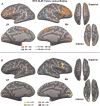Clear signals or mixed messages: inter-individual emotion congruency modulates brain activity underlying affective body perception
- PMID: 27025242
- PMCID: PMC4967801
- DOI: 10.1093/scan/nsw039
Clear signals or mixed messages: inter-individual emotion congruency modulates brain activity underlying affective body perception
Abstract
The neural basis of emotion perception has mostly been investigated with single face or body stimuli. However, in daily life one may also encounter affective expressions by groups, e.g. an angry mob or an exhilarated concert crowd. In what way is brain activity modulated when several individuals express similar rather than different emotions? We investigated this question using an experimental design in which we presented two stimuli simultaneously, with same or different emotional expressions. We hypothesized that, in the case of two same-emotion stimuli, brain activity would be enhanced, while in the case of two different emotions, one emotion would interfere with the effect of the other. The results showed that the simultaneous perception of different affective body expressions leads to a deactivation of the amygdala and a reduction of cortical activity. It was revealed that the processing of fearful bodies, compared with different-emotion bodies, relied more strongly on saliency and action triggering regions in inferior parietal lobe and insula, while happy bodies drove the occipito-temporal cortex more strongly. We showed that this design could be used to uncover important differences between brain networks underlying fearful and happy emotions. The enhancement of brain activity for unambiguous affective signals expressed by several people simultaneously supports adaptive behaviour in critical situations.
Keywords: amygdala; body perception; emotion; fMRI; occipito-temporal cortex; parietal lobe.
© The Author (2016). Published by Oxford University Press. For Permissions, please email: journals.permissions@oup.com.
Figures





Similar articles
-
Looking at the face and seeing the whole body. Neural basis of combined face and body expressions.Soc Cogn Affect Neurosci. 2018 Jan 1;13(1):135-144. doi: 10.1093/scan/nsx130. Soc Cogn Affect Neurosci. 2018. PMID: 29092076 Free PMC article.
-
Dissociable neural pathways are involved in the recognition of emotion in static and dynamic facial expressions.Neuroimage. 2003 Jan;18(1):156-68. doi: 10.1006/nimg.2002.1323. Neuroimage. 2003. PMID: 12507452
-
Show me how you walk and I tell you how you feel - a functional near-infrared spectroscopy study on emotion perception based on human gait.Neuroimage. 2014 Jan 15;85 Pt 1:380-90. doi: 10.1016/j.neuroimage.2013.07.078. Epub 2013 Aug 3. Neuroimage. 2014. PMID: 23921096
-
Distributed and interactive brain mechanisms during emotion face perception: evidence from functional neuroimaging.Neuropsychologia. 2007 Jan 7;45(1):174-94. doi: 10.1016/j.neuropsychologia.2006.06.003. Epub 2006 Jul 18. Neuropsychologia. 2007. PMID: 16854439 Review.
-
The perception of emotion in body expressions.Wiley Interdiscip Rev Cogn Sci. 2015 Mar-Apr;6(2):149-158. doi: 10.1002/wcs.1335. Epub 2014 Dec 22. Wiley Interdiscip Rev Cogn Sci. 2015. PMID: 26263069 Review.
Cited by
-
Differential neurodynamics and connectivity in the dorsal and ventral visual pathways during perception of emotional crowds and individuals: a MEG study.Cogn Affect Behav Neurosci. 2021 Aug;21(4):776-792. doi: 10.3758/s13415-021-00880-2. Epub 2021 Mar 16. Cogn Affect Behav Neurosci. 2021. PMID: 33725334
-
How white and black bodies are perceived depends on what emotion is expressed.Sci Rep. 2017 Jan 27;7:41349. doi: 10.1038/srep41349. Sci Rep. 2017. PMID: 28128279 Free PMC article.
-
Looking at the face and seeing the whole body. Neural basis of combined face and body expressions.Soc Cogn Affect Neurosci. 2018 Jan 1;13(1):135-144. doi: 10.1093/scan/nsx130. Soc Cogn Affect Neurosci. 2018. PMID: 29092076 Free PMC article.
-
Threat Detection in Nearby Space Mobilizes Human Ventral Premotor Cortex, Intraparietal Sulcus, and Amygdala.Brain Sci. 2022 Mar 15;12(3):391. doi: 10.3390/brainsci12030391. Brain Sci. 2022. PMID: 35326349 Free PMC article.
-
An fMRI study of crossmodal emotional congruency and the role of semantic content in the aesthetic appreciation of naturalistic art.Front Neurosci. 2025 Jul 30;19:1516070. doi: 10.3389/fnins.2025.1516070. eCollection 2025. Front Neurosci. 2025. PMID: 40809398 Free PMC article.
References
-
- Amunts K., Kedo O., Kindler M., et al. (2005). Cytoarchitectonic mapping of the human amygdala, hippocampal region and entorhinal cortex: intersubject variability and probability maps. Anatomy and Embryology, 210(5–6), 343–52. - PubMed
-
- Barbas H. (2000). Connections underlying the synthesis of cognition, memory, and emotion in primate prefrontal cortices. Brain Research Bulletin, 52(5), 319–30. - PubMed
-
- Calvo M.G., Esteves F. (2005). Detection of emotional faces: low perceptual threshold and wide attentional span. Visual Cognition, 12(1), 13–27.
MeSH terms
Grants and funding
LinkOut - more resources
Full Text Sources
Other Literature Sources
Molecular Biology Databases

